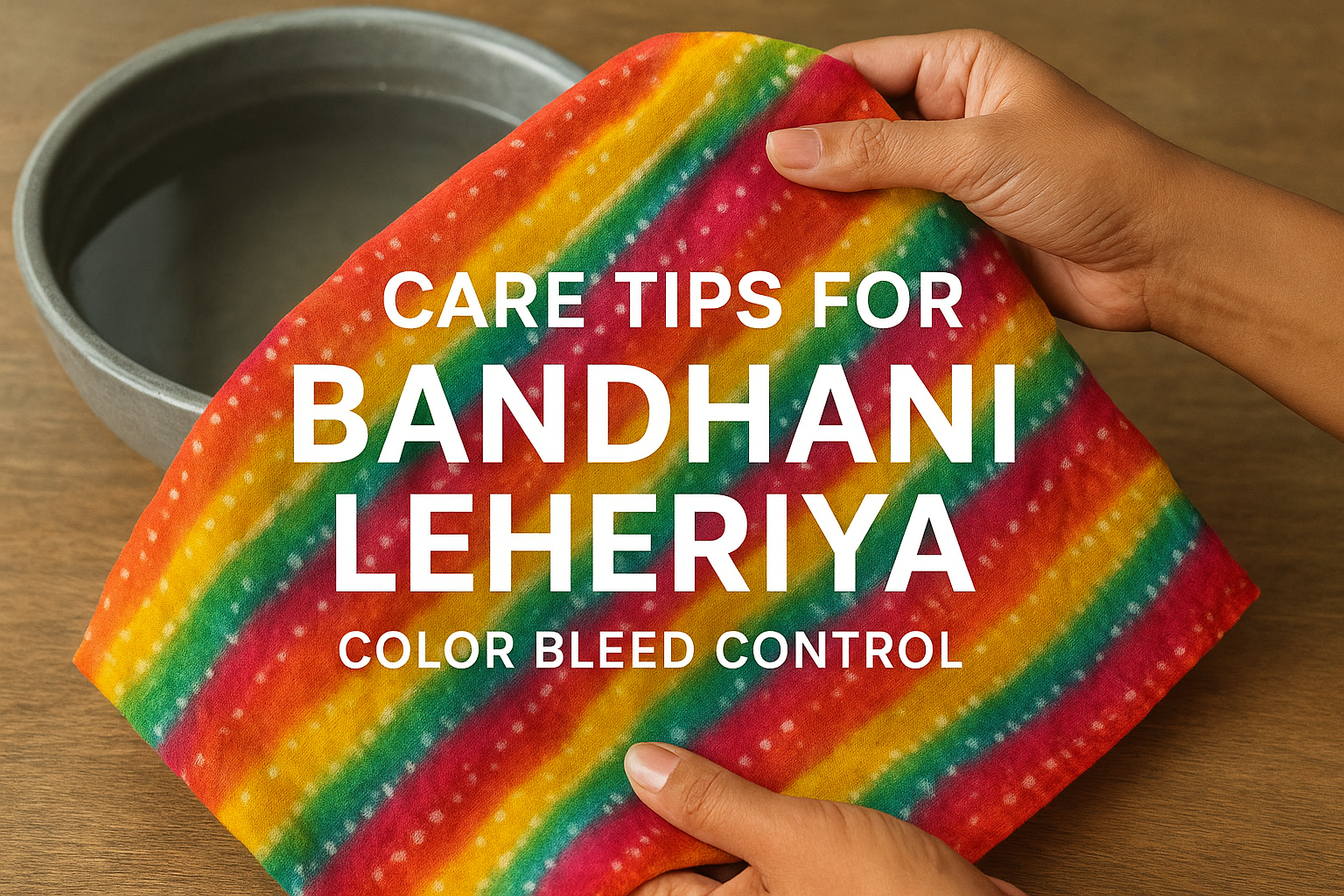Care Tips for Bandhani Leheriya: Color Bleed Control

A bandhani leheriya saree is an amazing creation of little tie dots and diagonal waves. The bold colors of the dye fields contrast crisp whites, the pallu flows for a visual effect like water, and it looks amazing in every photo at a wedding.
The only thing that takes away from that glow is color bleed. Heat, sweat, long soaks, vigorous hand washing with harsh soap, or a wet pile sitting on a chair can tease dye into the whites and cause the edges to appear fuzzy.
The good news is, you can keep the strokes 'clean' by following a simple routine, testing with a few simple water tests, and being careful in real-life instances, such as rain, travel day, or hour-long dance sessions.
Why Bleed Happens in the First Place
Hand-dyed cloth holds life inside the yarn. This life includes micro-tonal variations as well as a touch of loose color just after it arrives. Dark colors are a greater risk than pale. Humidity, a perfume too close before wear, or a long soak can nudge color into the closeby area.
Gota Patti in bandhani and leheriya sarees introduces one more variable because metal trim does not like long baths or hot irons. If you can identify these triggers, not only do you prevent or minimize risk, you begin to form habits that keep whites bright in a bandhani and leheriya sarees wardrobe.
A Two-Minute Check Before First Wear
Lay the saree on a clean bed. Pick a hidden corner near the inner fall. Dampen a white cotton pad and press for five seconds, then lift. A whisper of tint is normal, heavy streaks signal caution. Now flip the cloth. Reverse tones should look almost as deep, only a touch lighter, with white lines still white.
That balance tells you dye reached well into the yarn and will behave under a short rinse. If you’re buying leheriya bandhani saree online, you can check for some closeup photos, reviews, price, and most importantly, seller-reputation.
First-Rinse Routine That Locks Color Gently
Think short, cool, and still. No long soaks and no aggressive scrubs.
- Fill a bucket with cold water, add a short squeeze of some mild liquid soap, and swirl with your hand once. Submerge the saree for two minutes, no longer. Keep the fabric moving slowly so the water can get to all of the folds.
- Lift it out, and drain, then refill the bucket with clean cold water. Give it a quick rinse.
- Press the moisture out between two towels. No twisting.
- Lay flat on a wide hanger or a clean towel line in full shade.
- Once the surface moisture leaves the saree, immediately move it to a fresh dry towel to avoid the edges wicking any color into the whites.
A color-catcher sheet placed in the rinse will help pick up the loose tint. Use it as a helper, not a license to soak longer.
Spot Rescue When a Drop Hits the Pallu
Dinner might create a surprise attack, such as curry or wine. So, be very careful.
Immediately soak up the marks with a dry paper towel, and to avoid making it worse, put a towel under the marked area to prevent moisture from running down. Blot the mark with a cooler, slightly damp cotton pad, and lift straight up.
No rub or circles, only small dabbing motions. Let the mark air dry out of direct sunlight. If a faint halo remains, repeat the treatment in a few hours. In less typical runs for your whites only, a tiny dab of an oxygen-based stain solution can offer a little help with cotton buds. Test it on a fold first and limit contact time.
Suppose you’re having dinner, and your pleats get splattered with rasam. Blot, dab a cotton pad once with cool water, then air dry on the chair back. The mark will fade down to a soft dot, and when you wash it next, it is entirely gone.
Drying and Ironing That Protect Whites
When sunlight hits wet fabric, it can push color into adjacent areas and dull vibrant colors. Dry in a shaded area with movement. Use a wide hanger so the pallu doesn’t pinch into a point.
When ironing, flip the piece inside out, put a layer of thin cotton on top, and use low heat. Move the iron, don’t park it. For Gota Patti, press around the embroidery work and use fingertip pressure while warm to shape tiny bumps.
Sweat, Rain, Perfume, and Makeup
Apply perfume and hair spray before draping and give it a minute to settle. During monsoon weeks, line the blouse underarm with a slim guard or a light cotton pad so sweat does not sit on the same zone for hours.
Carry a tiny scarf in your clutch during baraat or open-air sangeet, then lift the scarf between saree and arm when you feel heat building. For makeup, choose transfer-resistant lipstick during hugs, and blot once before you step onto stage.
Storage That Keeps Color Calm
Color behaves well in breathable wrap and cool cupboards. Fold along the border so stitching stays safe, slide a sheet of soft cotton between layers, and drop two silica pouches nearby. Avoid plastic sleeves that trap moisture. Every few weeks, refold along a new line so no hard crease etches into whites.
If your wardrobe is against a humid wall, create just a bit of air space and put a drying block on the shelf. When you get your perfume and hair products on, spray it before you cover the bandhani leheriya and let it settle for a minute or so.
If it's during monsoon weeks, you may want to line the inner arm of the blouse with a thin guard or thin cotton pad, so it's not the same area sitting with sweat for hours. For makeup, choose transfer-resistant lipstick during hugs, and blot once before you step onto stage.
Storage That Keeps Color Calm
Color has its best behavior wrapped in breathable fabric and in cool cupboards. Always fold along the edge, so the stitching is intact, slide some thin cotton between layers, and drop in two silica pouches nearby.
Do not use a plastic sleeve which keeps moisture in. Every few weeks, unfold along a different line, so that no hard edge etches into your whites. If your cupboard is next to a damp wall, add a little air, and you may want to put a drying block on the shelf.
Travel Routine for Bandhani Leheriya Lovers
Roll instead of stuffing. Lay your saree flat, fold along the border, place a cotton scarf at the pallu, and roll it gently. When you pack your roll, pack it along the side of your suitcase so the compression straps will not squash the border.
When you arrive, hang it in the bathroom, and turn on the hot shower for a few minutes. The warm mist helps loosen travel wrinkles without requiring an iron. This works well with light georgette and chiffon as well as modal silk.
Fabric-Specific Notes
Light georgette and chiffon like a quick dip and shade dry. They bounce back quickly and will hold pleats with light coaxing. Pure silk would like even shorter dips and very low heat through a cotton layer.
Kota doria may take extra patience when longer, towel pressing, so the grid does not skew. For heavy Gota Patti over any base tela, do not dip. Pick targeted spot care or a trusted cleaner once in a while.
KCPC Bandhani Note
KCPC Bandhani sources a boutique selection of bandhani leheriya saree pieces with crisp whites, healthy color fields, and organized borders that are ready to wear in real spaces. Before shipping please go through our product pages to cherish the details.
You can also go through blouse ideas to limit your guesswork and increase the joy of every wear. Check our bandhani leheriya saree catalog today.
FAQs
How do I stop the color bleed on a new bandhani leheriya saree without harsh chemicals?
Use a short cold-water dip with a small squeeze of mild liquid soap, then one quick rinse. Press water out between towels, dry in shade, and avoid long soaks. A color-catcher sheet in the rinse can help trap loose tint.
Can I hand-wash a piece with heavy Gota Patti?
Avoid full baths for heavy Gota Patti. Use targeted spot care on plain zones and press around metal trims with low heat under a cotton layer. For deep cleaning on festival season picks, take it to a trusted cleaner and ask for a gentle method.
What should I do if rain hits the saree during an event?
Head indoors, hang the pallu on a chair back, and let air flow handle most of the work. Dab any pooling water with a towel, then allow shade drying. Do not rub wet bands. A brief cold-water rinse later can reset edges.
How can I read a leheriya bandhani saree online listing to predict color stability?
Request a daylight flip clip, a clear reverse photo, and a border slide. Look for near-equal depth on both faces and crisp white lines. A smooth color field without dot grids points to real dye work that behaves under a short rinse.
What storage setup keeps whites bright for years?
Wrap in breathable cotton, add silica pouches nearby, and refold along new lines every few weeks. Keep pieces away against damp walls and skip plastic sleeves so moisture does not sit inside the bundle.





